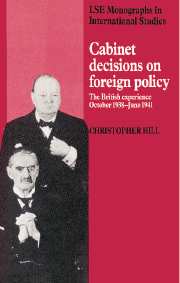Book contents
- Frontmatter
- Contents
- List of figures
- List of tables
- Acknowledgements
- Preface
- 1 Cabinets, foreign policies and case-studies
- 2 Constructing the Polish Guarantee, 15–31 March 1939
- 3 The Soviet question, April–August 1939
- 4 Entry into war, 1–3 September 1939
- 5 Reacting to the ‘peace offensive’, October 1939
- 6 To continue alone? May–July 1940
- 7 The longer term: War Aims and other committees, October 1940–June 1941
- 8 Decision-making in Cabinet
- Appendix 1 The Chamberlain Cabinet, 31 October 1938–3 September 1939
- Appendix 2 Attendance at the Foreign Policy Committee of the Cabinet, 14 November 1938–25 August 1939
- Appendix 3 Neville Chamberlain's statement in the House of Commons, 12 October 1939
- Appendix 4 Lord Halifax's paper for the War Aims Committee, October 1940
- Appendix 5 Anthony Eden's speech at the Mansion House, 29 May 1941 (extract)
- Notes
- Bibliography
- Index
- LSE MONOGRAPHS IN INTERNATIONAL STUDIES
4 - Entry into war, 1–3 September 1939
Published online by Cambridge University Press: 02 February 2010
- Frontmatter
- Contents
- List of figures
- List of tables
- Acknowledgements
- Preface
- 1 Cabinets, foreign policies and case-studies
- 2 Constructing the Polish Guarantee, 15–31 March 1939
- 3 The Soviet question, April–August 1939
- 4 Entry into war, 1–3 September 1939
- 5 Reacting to the ‘peace offensive’, October 1939
- 6 To continue alone? May–July 1940
- 7 The longer term: War Aims and other committees, October 1940–June 1941
- 8 Decision-making in Cabinet
- Appendix 1 The Chamberlain Cabinet, 31 October 1938–3 September 1939
- Appendix 2 Attendance at the Foreign Policy Committee of the Cabinet, 14 November 1938–25 August 1939
- Appendix 3 Neville Chamberlain's statement in the House of Commons, 12 October 1939
- Appendix 4 Lord Halifax's paper for the War Aims Committee, October 1940
- Appendix 5 Anthony Eden's speech at the Mansion House, 29 May 1941 (extract)
- Notes
- Bibliography
- Index
- LSE MONOGRAPHS IN INTERNATIONAL STUDIES
Summary
Another case in which the Cabinet enjoyed more than formal powers over a foreign policy decision was that of entry into the war itself, a choice faced directly during the two days following the German invasion of Poland on 1 September, and after weeks of anticipation and increasing tension. This climacteric has understandably attracted a good deal of attention from historians, and there is no need to rehearse its details at length here. However the events of 1–3 September provide dramatic material for the student of Cabinet decision-making, particularly in conditions of crisis, for they included one of the plainest Cabinet ‘diktats’ in British political history.
This was a very different type of decision from those which preoccupied ministers during the Soviet negotiations. Most obviously, the time-span of deliberation was very short at less than forty-eight hours. In one sense the urgency was self-imposed. Hitler had sent no ultimatum to Chamberlain or Daladier. At bottom, however, circumstances were dictating rapid action. The arrival at 7.28 a.m. on 1 September of a Reuters report of Hitler's broadcast announcing war with Poland raised the question of whether the casus foederis of the March Guarantee had finally arrived. His Majesty's Government were confronted with an unavoidable choice between war with Germany and the abandonment of their new policy of support for the vulnerable states of eastern Europe. The middle way, of negotiations on the basis of a status quo ante, was hardly realistic.
- Type
- Chapter
- Information
- Cabinet Decisions on Foreign PolicyThe British Experience, October 1938–June 1941, pp. 85 - 99Publisher: Cambridge University PressPrint publication year: 1991



